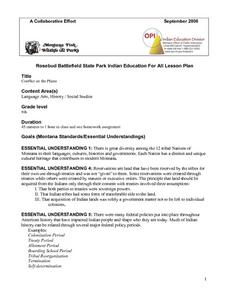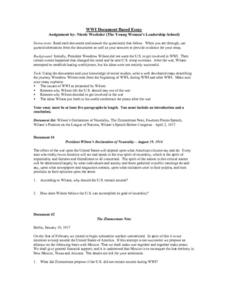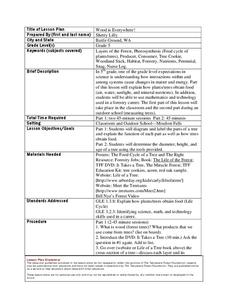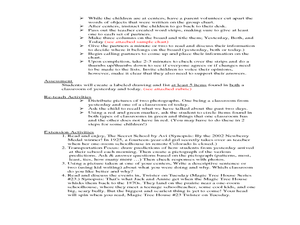Curated OER
Concrete Canoes
Students explore and analyze the relationship of buoyancy and displacement needed to make an object float. They examine various boat designs, then design and build clay and aluminum boats that hold a cargo of marbles.
Curated OER
Science of War
Tenth graders, from an environmental perspective, study the pros and cons of war. Distinctions between characteristics of biological, chemical and nuclear threats and the impact of economic development are considered.
Curated OER
Conflict On The Plains
Eighth graders investigate the culture and lifestyles of the Lakota Sioux and the Northern Cheyenne tribes. They use a variety of resources for research. They create questions based on information to be used during classroom discussion...
Curated OER
How Much Energy is a Kilowatt Hour?
Students study the conservation of energy. In this energy instructional activity students explain the differences between potential and kinetic energy.
Curated OER
Vibrant Volcanoes
Students explore volcanoes. In this science lesson, students discuss the characteristics of volcanoes and view a video segment about a volcano. Students examine plate tectonics.
Curated OER
Birthdays
Students recognize that there are different birthday customs unique to many countries.
Curated OER
Ford's Revolution (Differentiated by Ability)
Students explore the effects of Ford's use of the assembly line, auto financing, and increased wages to make his fortune. They complete a worksheet using the internet.
Curated OER
More Than Tipis and Feathers
Fourth graders research Native American People of the plains, the forest, the northwest coast and the desert. They compare how their lives were similar and how they were different. They make a model of one type of dwelling.
Curated OER
Octopus Legs
Students have oceans of fun transforming a wienie into an octopus they can eat! After counting, cutting halves and fourths, observing steam and the effects of heat, they mix colors as they create a yummy dipping sauce from mustard and...
Curated OER
Catch a Dream
Learners apply the concepts of air pressure, the Bernoulli Effect, and angle of attack to build their own model planes out of paper, plastic, wooden rods, and drinking straws.
Curated OER
What Do You Say... Psa Part One
Students investigate the differences between advertisements and public service announcements. They monitor their own reactions to educational messages as they pertain to warning about specific dangers and apply this to target audiences.
Curated OER
Japanese Culture
Seventh graders make connections with the history of Japanese art with the modern use of ancient warriors in the popular Yu-Gi-Oh trading cards. They journal and reflect upon the research and comparison of the ancient to modern art.
Curated OER
WWI Document Based Essay
Learners read various primary source documents on World War I. After reading each document, they answer discussion questions. Using the internet, they identify the causes of World War I as layed out by President Wilson and his reasons...
Curated OER
Population Dynamics
Students investigate the causes and consequences of population growth and the envrionmental factors that contribute to it. They discuss what they think the world's population will be in 2050.
Curated OER
The Awful Eight
Students investigate the concept of a carpool and its contributions to either reducing or increasing air pollution. They conduct research using a variety of resources for background information. The information is used to write a play...
Curated OER
Great Salt Lake
Fourth graders make an ecosystem that brine shrimp can live in and take data as to what level of salinity the water is, how cold it is, and other data that students may think is important. They also hypothesize and predict the outcomes...
Curated OER
Physical Principles in Living Systems
Seventh graders experiment with white light, plane mirrors, and curved mirrors in order to demonstrate the physical principles of living systems. In this physical principles lesson plan, 7th graders take 3 days to discover what happens...
Curated OER
Wood is Everywhere!
Fifth graders diagram and label the parts of a tree. For this lesson plan on how trees obtain food, 5th graders diagram and label the parts of a tree, and determine the diameter, height, and age of a tree.
Curated OER
Comparing the Confessional traditions that Emerge from the Reformation
Ninth graders examine the Protestant Reformation. In this World History instructional activity, 9th graders research various places of worship. Students comapre and contrast the different sects of religion that resulted from...
Curated OER
Classrooms: Then and Now
Students look at schoolhouses from the past. In this comparative analysis lesson plan, students visit a one room school house and look at the tools used for learning. Students then compare the schoolhouse of the past to the schoolhouse...
Curated OER
Colored Dots 1
Students observe that colored markers are a mixture of many different colors by performing a chromatography experiment. They make observations, record information, and make generalized inferences from their observations.
Curated OER
History Repeats Itself
Students read about an event that occurred 140 years ago to ascertain
information (who? what? when? where? why?) and to compare this event to Rosa Parks arrest almost 50 years ago. They retell the story from your point of view.
Curated OER
Dissolving Salt
Fifth graders, in groups, complete an experiment/activity in which they dissolve salt in a cup of hot water and then observe what happens as the water evaporates over the next few weeks.
Curated OER
Up, Up and Away
Third graders are presented with the problem of: Do all liquids evaporate at the same rate? The lesson contains adequate background information for the teacher. They participate in a lab experiment in order to test the scientific...























